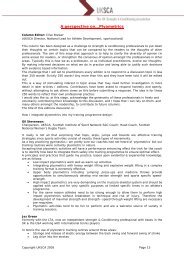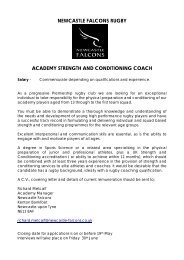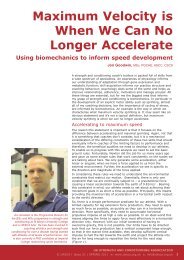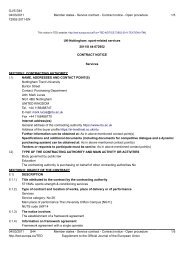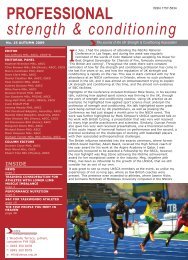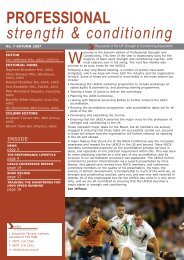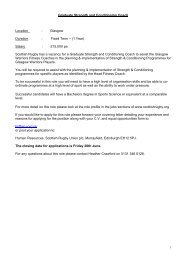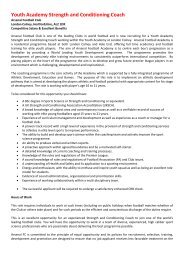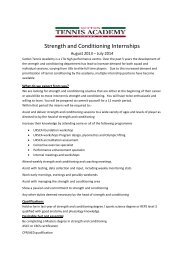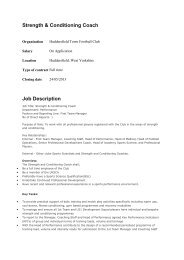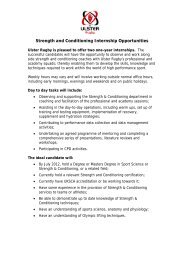uksca news june 2010.qxp
uksca news june 2010.qxp
uksca news june 2010.qxp
Create successful ePaper yourself
Turn your PDF publications into a flip-book with our unique Google optimized e-Paper software.
exactly known, however it is thought to have<br />
originated in the late 1980’s where programmes were<br />
designed to accommodate the intense playing<br />
schedules of American football players, by introducing<br />
two different training emphases during training<br />
sessions within a training week. 11<br />
It should be noted that the term linear periodisation<br />
itself is flawed, as nothing about the human body’s<br />
adaptation is linear in fashion. 34 Therefore, the term<br />
non-linear periodisation is incorrect in its concept, as<br />
all periodisation should be non-linear in fashion. 6,25<br />
Bondarchuk 5 discusses the need for varying training<br />
loads (% 1RM) during the microcycle, in order to<br />
modulate the intensities and workloads at various<br />
levels of the training process.<br />
The daily undulating model refers to the dramatic<br />
change of volume and intensity from one session to<br />
another, planned over the training week, 11 aiming to<br />
provide varying stimuli and supposed constant<br />
adaptation to different training loads. Fleck and<br />
Kraemer 11 suggest that each training session should<br />
target a different repetition maximum training zone,<br />
depending upon the requirements of the sport, for<br />
example within a training week of 3 sessions, zones<br />
may be performed at 4-6RM, 12-15RM and 8-10RM per<br />
set, all performed to volitional failure by the final set.<br />
Furthermore, Fleck and Kraemer 11 suggest a<br />
development on this model to flexible non linear<br />
periodisation, whereby the training session is chosen<br />
upon athlete arrival and is determined by pre training<br />
tests in order to establish readiness to train. This<br />
method has been designed to try and accommodate<br />
intense playing schedules, and by acknowledging signs<br />
of fatigue. It aims to manipulate training session<br />
emphasis, in order to achieve optimal performance<br />
gains. Readiness to train can potentially be assessed<br />
via a range of factors including coach-athlete<br />
interactions, current injury status, body mass,<br />
hydration and fluid intake, mental and physical fatigue<br />
ratings and vertical jump power. 11 It is proposed that if<br />
an athlete is showing significant signs of fatigue in<br />
tests then the training emphasis may be changed. For<br />
example, a power session may be planned, but power<br />
tests suggest the athlete is experiencing high levels of<br />
neural fatigue. Due to the sensitivity of power output<br />
to fatigue, it is suggested that training in a fatigued<br />
state would provide sub optimal training adaptation.<br />
In this instance, the emphasis of the session could be<br />
changed to encourage optimal adaptations from the<br />
training session. 11<br />
Although the idea of adapting the training load based<br />
upon pre testing is sound, the application within the<br />
undulating model is flawed. It is suggested that if<br />
excessive fatigue is present, a very light day of 16-<br />
20RM, with failure occurring on the last set, should be<br />
used with short rest intervals. In reality this would<br />
compound the fatigue problem, as the high workload<br />
prescribed would create excessive fatigue. Hartmann<br />
and colleagues, 15 suggest that the increased workload,<br />
(even with reduced intensity), coupled with short rest<br />
intervals, which would result in lactic acid accumulation<br />
and increased cortisol levels, creates excessive fatigue.<br />
Although pre training data may be valuable in<br />
determining the effect of different training stress on an<br />
individual, it is suggested that a well planned training<br />
programme can provide periods where fatigue is<br />
higher, due to overreaching, in order to achieve a<br />
positive training adaptation in the subsequent<br />
restoration period of the targeted training<br />
characteristic. This restoration can be achieved by<br />
maintaining repetition schemes and reducing the<br />
intensity of training (% 1RM), providing a more<br />
systematic management and control of fatigue. While<br />
the daily undulating model may provide a sufficient<br />
stimulus for short term training, longer term adaptation<br />
may be compromised.<br />
Block training<br />
Further evolutions of classic periodisation have been<br />
proposed by Issurin (Block periodisation) and<br />
Verkhoshansky (Conjugate Sequence System). Block<br />
periodisation suggests 3 components, which are<br />
termed mesocycle blocks, 19 and are titled accumulation,<br />
transmutation and realisation respectively. This design<br />
is to create concentrated means of stimuli for the elite<br />
athlete who responds more effectively to targeted<br />
abilities on training characteristics. 19,27<br />
In order to train the variety of training characteristics<br />
within a team sport, Issurin 19 suggests that each block<br />
should provide a level of targeted training to the<br />
stimulus within the preceding blocks. This provides<br />
consecutive developments of compatible training<br />
characteristics and infers a higher and more predictable<br />
effect. Issurin 19 proposes that the accumulation phase<br />
is allocated the longest training time, while the<br />
transmutation and realisation phase have shorter<br />
training times with the focus on event specific<br />
readiness, 19 Transmutation and realisation phase length<br />
are ultimately determined by the level and length of<br />
the accumulation phase.<br />
Conjugate Sequence System<br />
The Conjugate Sequence System (CSS) manipulates<br />
the strategy of overreaching in order to produce<br />
supernormal responses to training. 27 It involves periods<br />
of accumulation, followed by periods of restitution,<br />
during which supernormal responses occur. This is an<br />
advanced approach, which exploits the fitness fatigue<br />
characteristics, and focuses on developing one training<br />
characteristic during the accumulation phase. 12 Its<br />
structure involves a high volume of work for the<br />
chosen training characteristic during the accumulation<br />
phase, with maintenance type volume loads associated<br />
with other characteristics. 27 Following this, volume load<br />
is reduced markedly during the restitution phase with a<br />
moderate increase in the other training characteristics.<br />
These phases are commonly implemented in four week<br />
durations. 27 If implemented correctly, the athlete’s<br />
performance in the targeted training characteristic is<br />
positively affected via the delayed training effect<br />
phenomenon. 27 This method has been shown to elicit<br />
advantages when training the advanced athlete by:<br />
1) providing the potent training stressors required by<br />
advanced athletes for enhanced performance<br />
2) reducing the cumulative fatigue problems associated<br />
with concurrent training<br />
3) reducing work volumes in the long term but with an<br />
initial compromise in the short term 33,34,37<br />
Limitations of this system include the requirement of<br />
an environment with minimal constraints to training<br />
time, 27 and the requirement of more than two types of<br />
training characteristic, which are typically targeted in<br />
Conjugate Sequence System. 12 However, it does<br />
provide a method of training for the advanced athlete<br />
and provides superior training performance. It should<br />
UK STRENGTH AND CONDITIONING ASSOCIATION<br />
© UKSCA | Issue 18 | Summer 2010 w: www.<strong>uksca</strong>.org.uk e: info@<strong>uksca</strong>.org.uk 7



